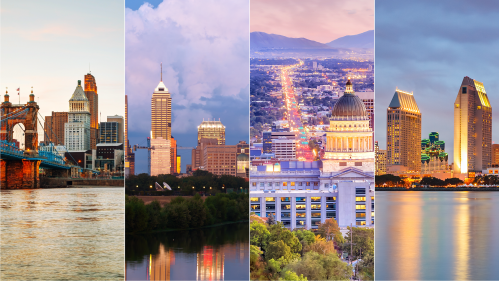In 2017, the state of Wisconsin agreed to provide $4 billion in state and local tax incentives to the electronics manufacturing giant Foxconn. In return, the Taiwan-based company promised to build a new manufacturing plant in the state for flat-screen television displays and the subsequent creation of 13,000 new jobs.
It didn’t happen. Those 13,000 jobs never materialized, and plans for the manufacturing plant have been consistently scaled back. Even if the project had gone through as planned, there is no way the Foxconn subsidy would have made money for the state, or provided earnings benefits for residents that exceed its costs. It now appears that few of Foxconn’s promises will be fulfilled, even though local governments have gone into debt over the project.
From 1990 to 2015, the size of these types of business incentives tripled. Foxconn-level incentives would escalate them another 10-fold, to 30% of state and local tax revenue. Such a surge threatens public services and the social safety net, turning a tool used to promote jobs and growth into a political and economic disaster.
Research suggests that at least 75% of the time, typical incentives do not affect a business’s decision on where to locate and create jobs—they’re all cost and no benefit. Furthermore, even when incentives do tip a location decision, they do not pay for themselves. They may create new jobs, but frequently they also bring in new workers from outside the city or state, which raises costs to public services that offset at least 90% of any increased revenue.
On average, only 10-30% of new jobs go to state residents who are not already employed. Only when new jobs increase employment rates—thus boosting local earnings and putting upward pressure on local wages—can they provide large and broadly shared local benefits.
There are possibilities for such well-designed tax incentives. When combined with business services and other smart policies, they can be a cost-effective way to promote inclusive local economic growth.
Here is a practical checklist for this method of incentive design, which every governor, mayor, legislator, and economic developer should follow to protect taxpayers and provide residents with better jobs. It applies to a broad range of incentives: job creation tax credits, investment or R&D credits, property tax abatements, as well as customized services for individual businesses such as job training, manufacturing extension services, or entrepreneur support. The checklist is backed by the most current research in the field, conducted by the W.E. Upjohn Institute, and just published by one of us in e-book form: Making Sense of Incentives: Taming Business Incentives to Promote Prosperity (available for free on the Upjohn website).
Do the incentives target the right businesses?
- Will the business provide multiplier effects? When the business buys from local suppliers, it helps increase jobs at those companies. Workers employed at the business, too, will buy from local retailers, increasing those jobs.
- Is the business “traded”—i.e., selling its goods and services outside of the state or community? Incentives to non-tradeable firms will just displace jobs at other local non-tradable firms.
- Is the real job multiplier accurately calculated? Multipliers can be overstated if they ignore the increased local costs that accompany business growth.
- Is the business locally owned? Locally owned firms spend more of their revenue locally, benefiting the hometown economy.
Do the incentives target the right areas?
- Incentives should target economically distressed local areas, with more available labor that is not employed. That way, the share of new jobs that go to local residents can be two to three times as great, compared to already-booming areas.
- Do the incentives target high-tech businesses in an area with an above-average high-tech base? High-tech businesses have additional multiplier effects because they support and spawn other local firms whose workers and ideas flow from one to another. But this only works when the area has a sufficiently large “cluster” of tech firms to build from.
Are they the right type of incentives?
- Are they structured so cash incentives occur upfront? Upfront incentives are more cost-effective in affecting business location decisions, because they are more relevant to business decisionmakers who focus on the short term.
- Do they include enticements/requirements to hire locally? For example, customized training programs can encourage firms to hire the local unemployed.
- Do they include a healthy share of customized businesses services, or is it all cash giveaways? Business services such as job training, business advice to smaller businesses, and new transportation infrastructure can have job creation effects per dollar that are five to 10 times greater than tax or cash incentives.
- Do the incentives avoid robbing Peter to pay Paul? If governments pay for incentives by decreasing public spending on education, training, or infrastructure, the negative economic development effects of those budget cuts may exceed any benefits from the incentives.
Finally, is there a decent model to accurately assess the impact of the incentive?
As outlined in Making Sense of Incentives, there are practical ways to evaluate incentives. We can compare assisted with unassisted firms, or assisted areas with unassisted areas. There are good estimates of how many location decisions will be swayed by a cash incentive package of a particular size, and how many jobs per dollar will be created by a high-quality customized job training program. State and local government researchers can combine these evaluation approaches with models of local labor markets and fiscal impact to see whether a specific incentive package’s benefits are likely to exceed its costs.
State residents can benefit from incentives to boost job creation—but not at any cost, or with poorly designed incentives. Effective incentives target economically distressed communities and truly high-multiplier firms. They include customized business services, which can do more per dollar to boost job creation. Lastly, they focus on creating jobs that go to the local unemployed—their largest potential social benefit.
The Brookings Institution is committed to quality, independence, and impact.
We are supported by a diverse array of funders. In line with our values and policies, each Brookings publication represents the sole views of its author(s).







Commentary
Most business incentives don’t work. Here’s how to fix them.
November 4, 2019